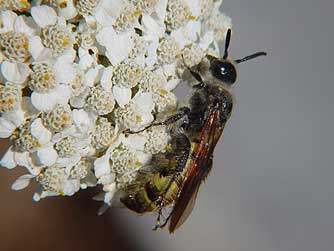 Scarab
hunter wasps look somewhat like yellowjackets with their yellow and black
stripes, but are larger, fatter, and have a black head. Scoliids also
have a distinct ecological difference from the vespids- they seek out
scarab beetle
larvae, an agricultural pest, to reproduce. The scarab hunter or scoliid
wasp burrows through soil or wood debris, finding, stinging and paralyzing
the beetle larva and laying an egg on the temporarily immobilized host.
The wasp egg hatches and the young wasp larva eats its host, dining on
the beetle larva for some time before gobbling it up in the end. After
having its fill of beetle and with space to stretch, it pupates underground. Scarab
hunter wasps look somewhat like yellowjackets with their yellow and black
stripes, but are larger, fatter, and have a black head. Scoliids also
have a distinct ecological difference from the vespids- they seek out
scarab beetle
larvae, an agricultural pest, to reproduce. The scarab hunter or scoliid
wasp burrows through soil or wood debris, finding, stinging and paralyzing
the beetle larva and laying an egg on the temporarily immobilized host.
The wasp egg hatches and the young wasp larva eats its host, dining on
the beetle larva for some time before gobbling it up in the end. After
having its fill of beetle and with space to stretch, it pupates underground.
The wasps in these pictures were observed emerging as adults
from burrows in a sandy bank beneath a hackberry
tree, the roots of which had likely been attacked by grubs of the
lined june beetle.
They also emerge from areas with bunchgrass
and antelope bitterbrush.
While their larvae feed on beetle larvae, adult scarab hunter
wasps forage for flower nectar, in the process pollinating many flowers
including white forget-me-not,
purple sage, yarrow,
chokecherry, elderberry,
western clematis and
other native plants.
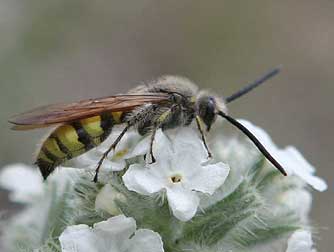
Scarab Hunter or Scoliid Wasp male
with long antennae, nectaring on white
forget-me-not flowers
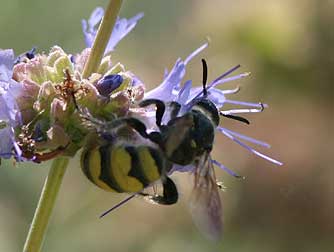
Scarab Hunter or Scoliid Wasp female
with short antennae, nectaring on purple
sage flowers
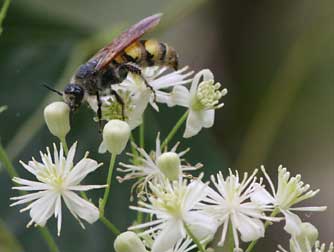
Scarab Hunter Wasp
nectaring on Western
clematis flowers
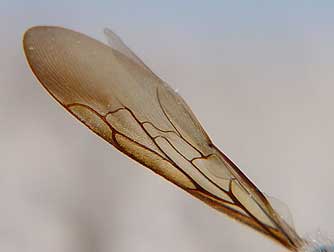
Wrinkled wing ends
distinguish Scoliid Wasps from Tiphiid Wasps
|

